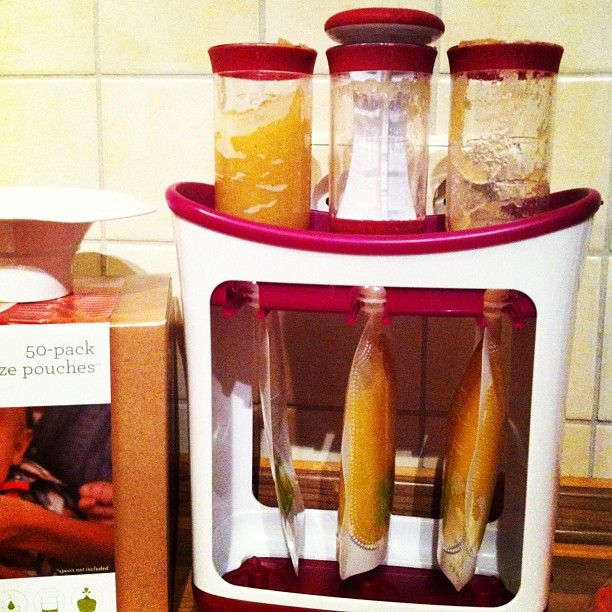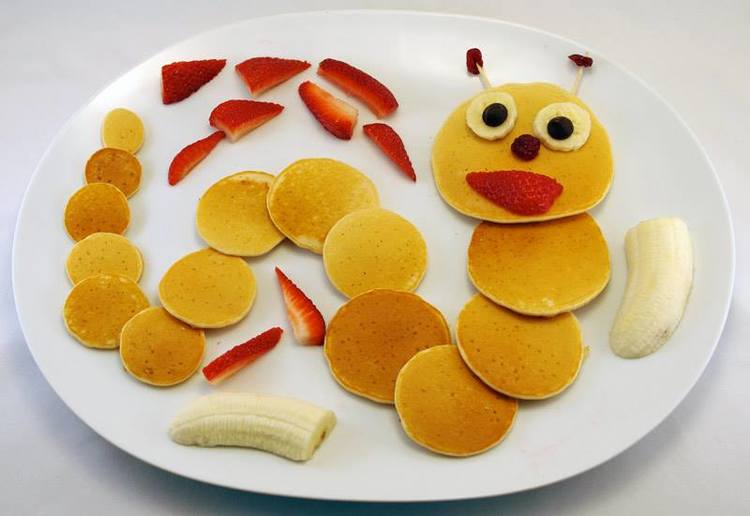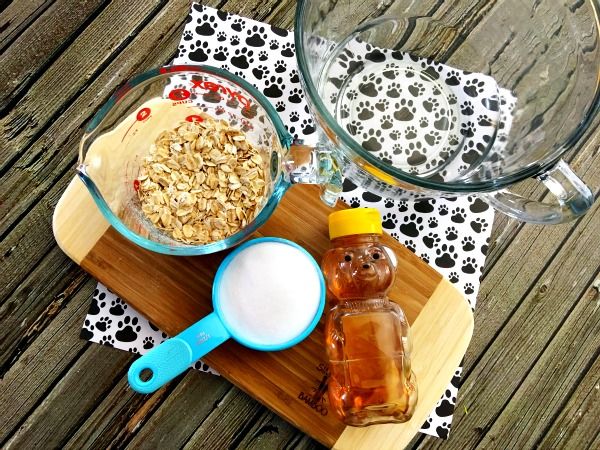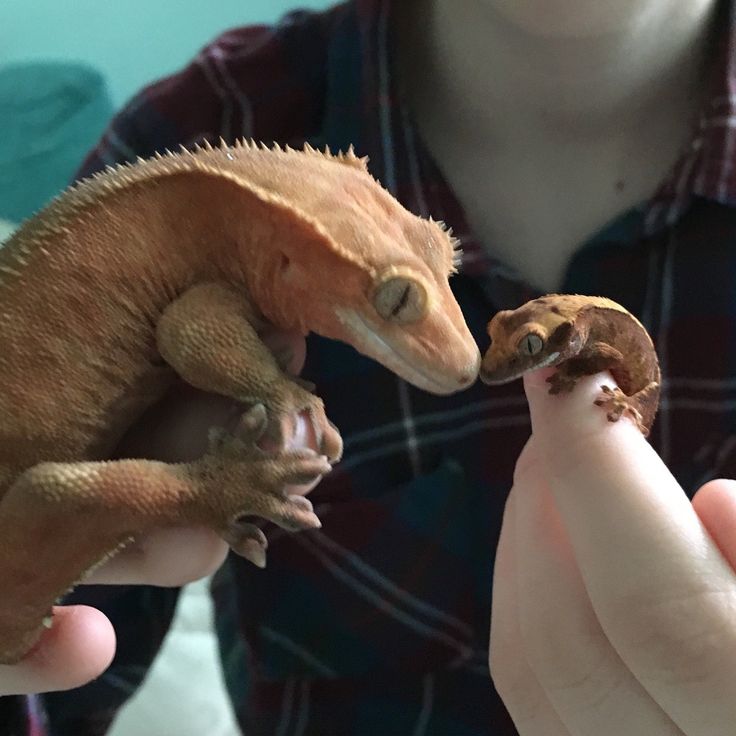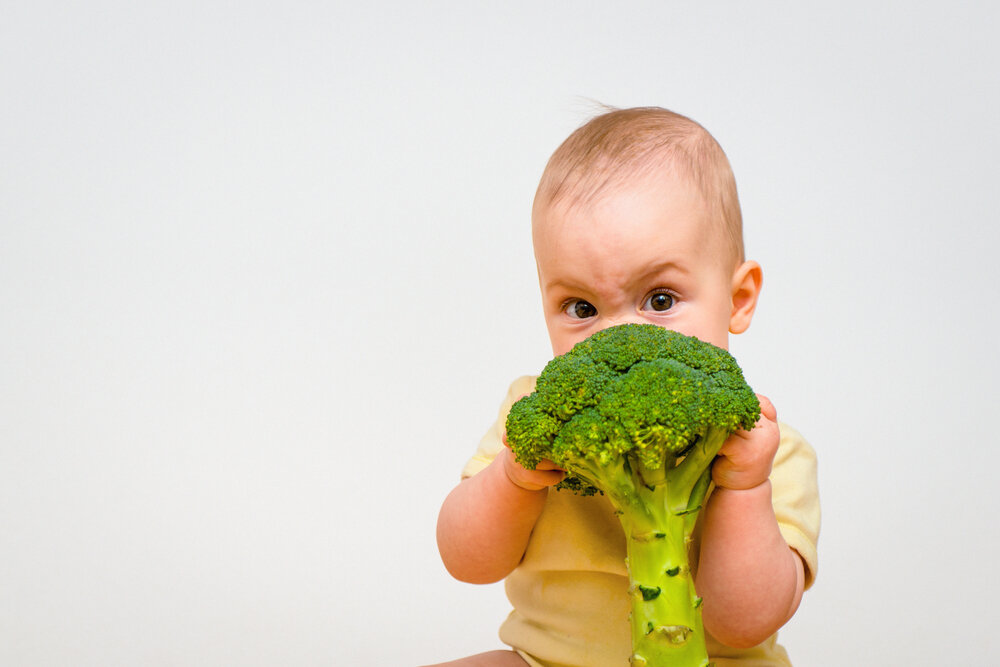When do babies learn to feed themselves
7 Tips for Teaching Your Baby to Self-Feed
Now that your baby has been introduced to solids and is experiencing different foods and flavors, you may be ready to help your little one begin to self-feed. But when is the right time to encourage this new skill? What are the signs of readiness that we should look for? And what are the best foods to begin with when teaching baby to self-feed? We are answering all of your questions and sharing our tips on making this milestone easier for you and your child.
When will my baby be able to self-feed?
Usually, by about nine to 12 months of age, you may notice your baby showing an interest in self-feeding. They have become more experienced with eating solids at this age and are feeling the different textures of foods between their fingers. Hopefully, they are also making attempts at bringing some of that food to their mouth to lick and taste. This usually looks like them grasping for their food with their whole hand in a raking-like motion and then trying to shove what they have in their hand all into their mouth. You may even notice your baby trying to grab the food with their thumb and forefinger, which is an important fine motor skill called the pincer grasp. These are all good signs and are great indications that your baby is ready to begin self-feeding.
What are the signs that my baby is ready to self-feed?
There are a few readiness signs to look for that will indicate it’s the right time to begin teaching your baby to self-feed:
- Grabbing the spoon while you are holding it during mealtime.
- Reaching for their food on their plate, bowl, or tray.
- Reaching for your food or plate.
- Practicing the pincer grasp — bringing food and other items to their mouth during mealtime or playtime.
- Pushing your hand away when you try to feed them.
It’s important to pay attention to these readiness signs and not just rely on your child’s age. If a baby is 9 or 10 months old but does not show these readiness signs, parents should wait until they do. But once your baby does show these self-feeding readiness signs, it’s important to provide many opportunities for them to practice this skill. Allow them to try and try again. That’s how they will learn and master this skill!
But once your baby does show these self-feeding readiness signs, it’s important to provide many opportunities for them to practice this skill. Allow them to try and try again. That’s how they will learn and master this skill!
What are the best foods to start with self-feeding?
The best foods to give your baby to practice self-feeding are easy for them to grab, hold, pick up, and bring to their mouth. Here are some recommendations to try:
- Stonyfield YoBaby Pouches
- Soft cooked carrots, sweet potatoes, butternut squash, or peas
- Small pieces of soft, ripe bananas, avocados, kiwi, or peaches
- Soft-cooked apples or pears
- Soft-cooked whole grain pasta
- Diced pieces of cooked chicken, turkey, or fish
- Cubes or strings of cheese
YoBaby® yogurt pouches are a great option for multiple reasons. First, they are easy for your little one to pick up and bring to their mouth. Second, they nourish little tummies with real fruit, live and active cultures, vitamin D, calcium, protein, and prebiotics! Third, the consistency is creamy and delicious — easy for baby to eat and swallow.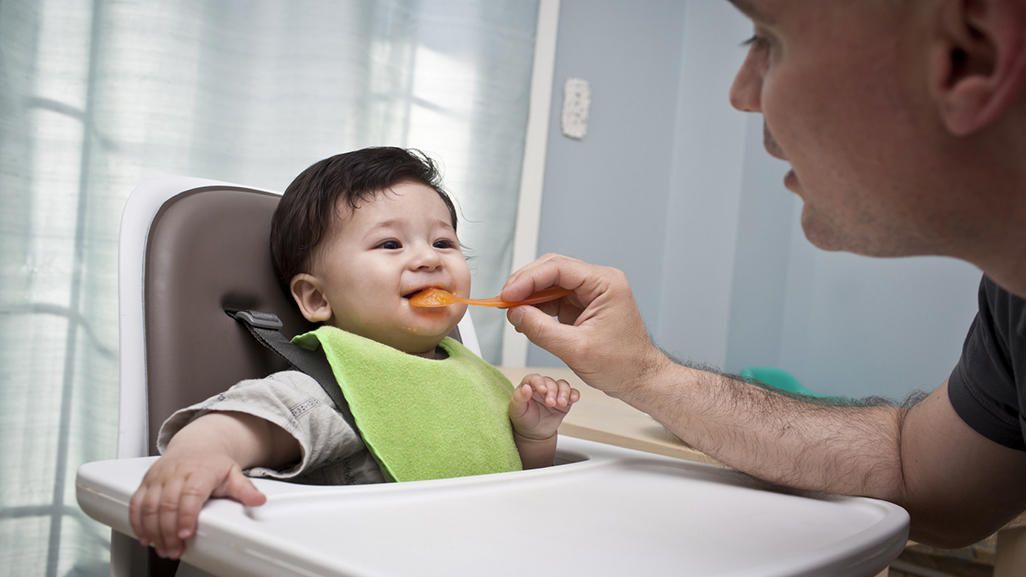 And four, it combines whole milk yogurt and oats for a quick meal for baby!
And four, it combines whole milk yogurt and oats for a quick meal for baby!
All foods should be soft, easy to mash, and big enough for your baby to pick up but small enough to prevent them from choking.
What are the foods to avoid when my baby is beginning to self-feed?
Foods that should be avoided when beginning to teach your baby to self-feed are foods that pose a potential risk of choking.
- Nuts
- Popcorn
- Raw carrots
- Whole grapes
- Raisins
- Hot dogs
- Portions of food that are too large
Your baby doesn’t have all of his teeth, so all foods should be soft. Once your baby’s 2-year molars come in, your child will be able to chew harder food properly. If you want to test to see which foods are safe and soft enough for your baby to eat, take a piece of their food and try to mash it between your fingers. If you cannot easily mash it, it’s probably too hard for your baby to chew.
How do I teach my baby to self-feed?
Now that you know your baby is ready to start self-feeding and you know which foods are best to start with, how do you begin? Here are some helpful tips.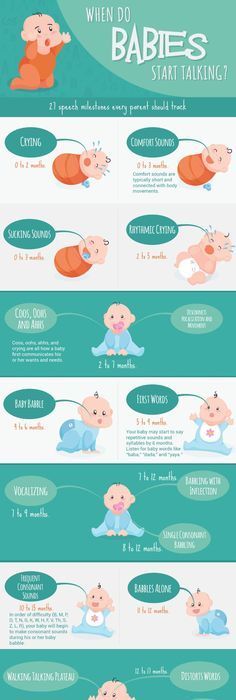
The more opportunities you give them to practice, the quicker they will learn and master self-feeding. Give them opportunities to try self-feeding with their hands and with utensils.
2. Begin with encouraging hand feeding.Before introducing feeding utensils to your baby, encourage her first to use her hands to move the food toward her mouth. A good way to start is to place a yogurt pouch or a few pieces of food on your baby’s highchair tray. Encourage her to reach for it, feel it, and play with it with her pincer grasp. It may look as if she isn’t doing much and not eating, but that’s actually how she starts to learn.
3. Also, introduce and encourage baby to use utensils.It’s never too early to introduce utensils to your baby! It’s good for them to get used to utensils during mealtime. In the beginning, I recommend having two spoons–one for you to help feed baby a few bites and one for them to hold and practice using. He may even try to imitate your motions by dipping his spoon into the food and maybe attempting to bring it to his mouth.
He may even try to imitate your motions by dipping his spoon into the food and maybe attempting to bring it to his mouth.
Another thing you can try is pre-loading his spoon with food and handing it to him. This can help him practice balancing the food on the spoon as he brings it to his mouth. With this, I recommend using thicker foods like yogurt and oatmeal. They are good practice foods since they stick more easily to the spoon. Overall, be sure to allow plenty of practice opportunities with both utensils.
4. Stay close to your baby during meals.As your baby practices self-feeding, it’s important that you stay close and monitor her. We don’t want any food getting stuck in her nose or anywhere else, and you want to ensure that she is tolerating all of the new textures and flavors. By staying close, you will also monitor how much or little she is putting in her mouth and eating. These are all reasons why remaining by her side is necessary. She’s learning something new, and she needs your help and guidance!
5. Be prepared and expect a big mess.
Be prepared and expect a big mess.When babies are allowed to touch and explore new foods and feeding themselves, things get messy. And that’s okay! Don’t stress about it, and expect the mess. Have your baby wear a baby apron, put a towel on the floor if you’re worried about food falling, or undress your baby down to her diaper! Also, have baby wipes and power towels close by. You may even have to give your baby a bath after mealtime. Again, this is normal. A messy meal is still a success because that means your baby was trying to self-feed. Soon enough, she’ll get better at handling the different foods and make less of a mess. This is all a part of the process.
6. Eat together as a family.One of the best ways to teach your baby to self-feed is to have them watch the family eat. Babies are learning new things all the time, and they learn from modeled behaviors. By watching how their parents and siblings use their utensils and eat their food, babies want to mimic the same behaviors. They gain confidence watching you and believe that they can do it too! If you are feeding your baby at a different time than the rest of the family, they are missing out trying to mimic your movements with utensils and foods and observing other appropriate mealtime behaviors.
They gain confidence watching you and believe that they can do it too! If you are feeding your baby at a different time than the rest of the family, they are missing out trying to mimic your movements with utensils and foods and observing other appropriate mealtime behaviors.
It takes time to learn how to self-feed, so be patient with your little one. Don’t try to rush the process or mealtimes. Your baby should set the pace because they understand their hunger and fullness cues. This is why it’s good to allow plenty of time for their meals. With lots of practice and patience, your baby will be self-feeding in no time!
What if my baby starts gagging or choking?
When teaching your baby to self-feed, expect some gagging to occur. Gagging is a natural occurrence and is the body’s natural defense against choking. This happens when babies have too much food in their mouth and are presented with new textures and flavors.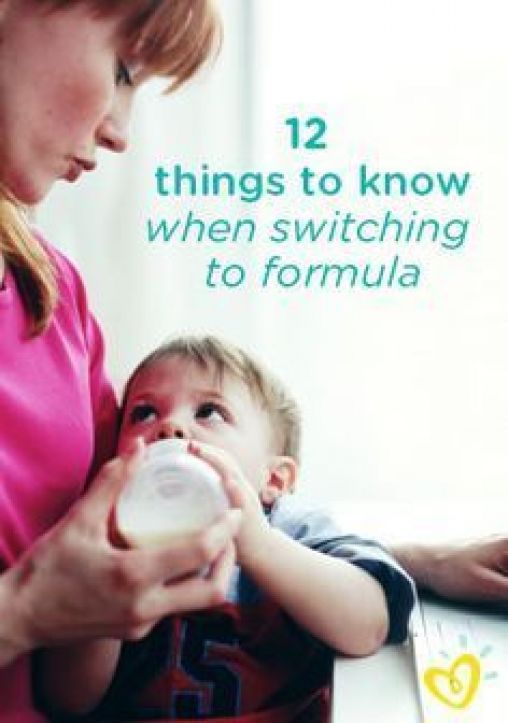 As long as they aren’t gagging too much during mealtime or causing them distress, gagging is common. However, if they are frequently gagging when trying to self-feed, this can cause them to have negative associations with eating or eating aversions. If this happens, avoid giving those foods or preparing those negative associations at the next mealtime.
As long as they aren’t gagging too much during mealtime or causing them distress, gagging is common. However, if they are frequently gagging when trying to self-feed, this can cause them to have negative associations with eating or eating aversions. If this happens, avoid giving those foods or preparing those negative associations at the next mealtime.
Choking, however, is different and much more serious than gagging. Choking is when a piece of food gets lodged in the airway. Your baby may first begin coughing, then become silent. He will show difficulty breathing and will not be able to cry or make sounds due to the food obstructing his airway. This is a serious and life-threatening matter. This is why the types of food, foods’ sizes, and the consistency of foods are important when teaching your baby to self-feed.
Final Thoughts
This is an exciting time in your baby’s development. Remember, self-feeding is a learning process and takes time. If you see that your baby isn’t able to self-feed enough foods to fill them up during mealtime, which is common in the beginning, alternate feeding them purees and finger foods to fill them. I also suggest offering them a YoBaby yogurt pouch to fill them and allow them to continue practicing self-feeding! In the meantime, take lots of pictures of this fun and messy milestone and enjoy the process!
I also suggest offering them a YoBaby yogurt pouch to fill them and allow them to continue practicing self-feeding! In the meantime, take lots of pictures of this fun and messy milestone and enjoy the process!
Note that the views and opinions expressed in this post are solely that of Baby Chick and do not necessarily reflect the opinions and views of Stonyfield. The content provided and in any linked materials are not intended and should not be construed as medical advice. If you have any questions about health or nutrition, we always think it’s best to consult with your doctor or healthcare practitioner.
When to Introduce a Spoon to Baby – Ready. Set. Food!
Learning how to self-feed is an important milestone in your baby’s development. The messy, but fun, process of teaching your baby how to use a spoon will be the next step in your baby’s journey to self-feeding.
Teaching your baby how to self-feed is going to be a messy process, but will be worth it in the long run. Your baby's motor skills and development will benefit from learning how to self-feed so it is important to encourage this process to your baby. As you begin to approach the age where your baby is ready to start learning how to self-feed, here is everything you should consider.
Your baby's motor skills and development will benefit from learning how to self-feed so it is important to encourage this process to your baby. As you begin to approach the age where your baby is ready to start learning how to self-feed, here is everything you should consider.
Where To Start
Finger Feeding
Before you start to think about introducing a spoon to your baby, you first will want to make sure your baby has been introduced to finger foods. This first step will help your baby begin to develop their motor skills which are necessary to have before figuring out how to use a spoon.
Beginning with finger foods, start with soft foods that you can easily smash with your fingers. This will be the safest and easiest place to start for your baby. Foods such as soft cooked noodles, cut bananas, or steamed veggies are all a good place to begin. Choosing foods that can be cut up into bigger chunks will also make it easier for your baby to be able to pick up.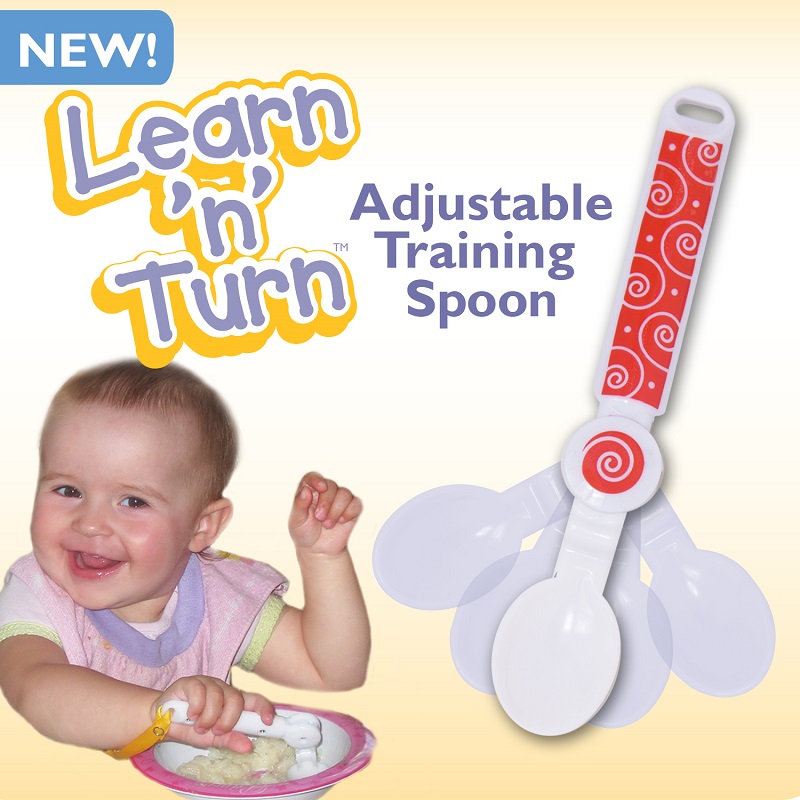
If you have only been feeding your baby soft foods and purees on your own, you should wait to introduce a spoon until after you have introduced finger foods. At around 12 months, most babies should be feeding themselves finger foods. It is around this stage that you can start to introduce a spoon.
Next Step: Introducing the Spoon
Now that your baby has gotten comfortable with finger feeding, you can take the next step on the self-feeding journey by introducing their first utensil, a spoon. The CDC recommends waiting to introduce a spoon to your baby until they are around 10-12 months old. However, there is no specific age or time that your baby should developmentally be using a spoon. There are many factors that can have an influence on the timing of your baby learning to use a spoon.
- Fine motor skill development
- Interest in eating independently
- Time they have been eating solid foods
- First introduced to finger foods
These are all factors that can influence when your baby starts to use a spoon to self-feed. Every child is unique so do not worry about whether or not your baby is successfully learning to use a spoon. They will get there eventually!
Every child is unique so do not worry about whether or not your baby is successfully learning to use a spoon. They will get there eventually!
Signs They Might Be Ready
It can be tricky to know whether or not your baby is ready to take the next step in their development. One sign that your baby is likely ready to start using a spoon on their own is with their body language. Infants typically will turn their heads and clamp their mouth to signal they are full, after the meal. The opposite holds true as they get older. Toddlers will often start to get fussy or throw a tantrum before a meal. If you are noticing that they are appearing disinterested in the spoon you are trying to feed them, let themselves give it a try. This might be their way of telling you they are ready to be more independent.
Learn more from Pediatrician Dr. David Hill from the American Academy of Pediatrics about when your baby is ready for solids:
Expected Timeline
Depending on your baby, these milestones will be reached at different times than the families around you. However, here is a general guide to understanding when you should plan on your baby reaching these steps to independently self-feeding.
- 6 months: You can begin to start introducing finger foods to build your baby’s fine motor skills. Remember to choose foods that are soft and easy to squish to avoid any choking hazards.
- 12 months: Around their first birthday, your baby will likely begin showing an interest in using a spoon themselves. This is when you can begin letting your child feed themselves thick, soft foods like oatmeal, yogurt, or applesauce.
- 15-22 months: Your toddlers should be able to start getting the hang of feeding themselves with a spoon.
 Around this time, you should also be able to introduce using a fork to feed themselves.
Around this time, you should also be able to introduce using a fork to feed themselves.
Every baby is different when it comes to reaching these developmental milestones. You should never focus too much on whether or not your baby is “on track.” With both time and practice, your baby will get there.
What are the Benefits of Self-Feeding?
Self-feeding is your baby’s first step to independence. In addition to the new confidence and sense of freedom your baby is experiencing, self-feeding is beneficial to their overall development in the following ways.
- Learning to grasp and hold things firmly
- Gaining hand-eye coordination (learning spatial awareness, strengthening their “visual motor skills”)
- Refining Sensory Process skills (the different textures and sensations of the food they are touching will help to build their sensory processing skills)
Things to Consider
Picking the Right Spoon
In general, any spoon that is not too heavy for your baby to hold is the right spoon. However, it is probably a good idea to purchase a set of spoons that are actually designed to be used for babies. Look for spoons that have a wide, chubby handle that will make it easy for your baby to grab and pick up. A spoon made of rubber or silicone will also be better for your baby because of the soft texture and grippy material.
However, it is probably a good idea to purchase a set of spoons that are actually designed to be used for babies. Look for spoons that have a wide, chubby handle that will make it easy for your baby to grab and pick up. A spoon made of rubber or silicone will also be better for your baby because of the soft texture and grippy material.
Foods to Start With
Get ready for a big mess when it comes to your baby learning how to use a spoon. At first, your baby will likely spend more time exploring and playing with their food, rather than actually eating it. Start with thick foods that will easily stay on the spoon as they learn how to balance and bring the spoon to their mouth. Here are some recommended foods to start with.
- Applesauce
- Cottage cheese
- Mashed peas/carrots
- Mashed potatoes
- Oatmeal
- Pasta
- Pudding
- Yogurt
Introducing the Fork
So, your baby has now mastered the spoon and is ready for their next big step: the fork. It is usually recommended to introduce the spoon before the fork, because a spoon is typically easier for a baby to learn at first. However, some babies do pick up on the fork easier because it requires less balancing and they can stab the food. You will likely want to introduce the fork at around 16-18 months, to give your baby time to first practice and focus on learning how to use a spoon.
It is usually recommended to introduce the spoon before the fork, because a spoon is typically easier for a baby to learn at first. However, some babies do pick up on the fork easier because it requires less balancing and they can stab the food. You will likely want to introduce the fork at around 16-18 months, to give your baby time to first practice and focus on learning how to use a spoon.
What’s Next?
With so many huge developmental milestones being achieved, your baby is rapidly developing. Once your baby has been introduced to the spoon and fork, you can consider moving them from the high chair to a booster seat at the table. By bringing your baby to the table to eat with you, you can help them develop their motor skills quicker. This gives them the opportunity to observe and mirror your actions.
How Can I Help the Process?
The best way you can help your baby is to simply let them experience and explore this new skill for themselves. At first, you'll probably notice that your baby spends more time playing and waving the spoon around.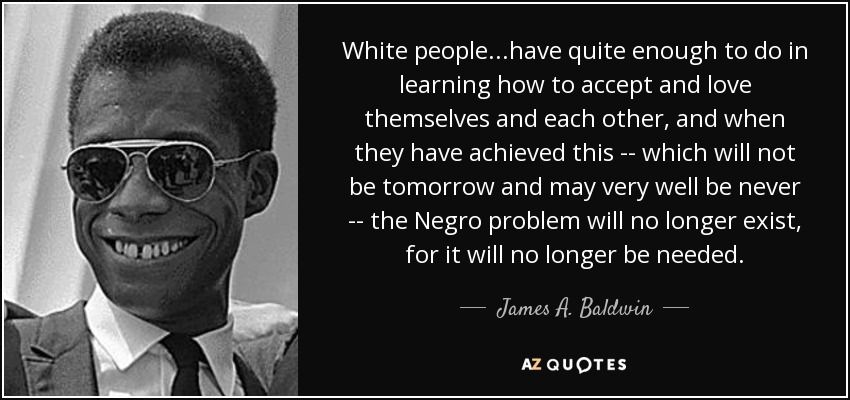 But eventually, they will start to pick up on how to actually use the tool for their self-feeding benefit.
But eventually, they will start to pick up on how to actually use the tool for their self-feeding benefit.
This is a messy, but fun, process. Look into some rubber or silicone splat mats to make the clean up aftermath easier for you. Other than letting your baby explore and have fun with the learning process, here are some things you can do to help your baby with practicing their new skill.
- Demonstrate it for them: Your baby is looking to you for guidance, so show them how it is done! Have them watch you use a spoon to feed yourself the yogurt or oatmeal and then have them try it for themselves. Over time, they will continue to mirror your actions for how to self-feed.
- Hand-Over-Hand Method: First, let your baby grab for the spoon themselves. Once they are holding the spoon, see if they can dip the spoon and scoop up the food. You can place your hand over their hand and help guide the food into their mouth. Your baby is still learning all the basics like where their mouth even is and how to scoop food using the spoon so you can help show them the ropes for the first few times.

- Stick to Thick Foods: To make it easier for your baby to scoop and bring the food into their mouth, stick to thick foods at first. Avoid foods that can easily fly off the spoon (rice, cereal, etc.) until they have gotten used to the process.
Baby-Led Weaning: What is it?
Baby-Led Weaning is a popular form of teaching self-feeding. The process skips feeding soft foods and purees and goes straight to finger foods starting at around 6 months. Registered dietician, Clancy Cash Harrison, author of Feeding Baby, says “Baby-led weaning supports the development of hand-eye coordination, chewing skills, dexterity, and healthy eating habits,” she says. “It also offers babies an opportunity to explore the taste, texture, aroma, and color of a variety of foods.”
What makes baby-led weaning successful, is that your baby will recognize that in order to eat, they need to learn how to do it themselves. It gives an extra nudge into independence. However, parents can obviously step in when needed, in order to make sure their baby is getting enough nutrition from food.
However, parents can obviously step in when needed, in order to make sure their baby is getting enough nutrition from food.
Starting at about 6 months, or whenever your baby is able to sit unassisted in a high chair, you can begin baby-led weaning. Your baby might not have fully developed their chewing skills so breast milk or formula will still need to be their main source of nutrition until at least 10 months old.
The best foods to begin with are soft, easy to squish foods like bananas, steamed broccoli, or avocado. Try cutting the foods into bigger pieces to make it easier for them to pick up. By starting at 6 months, you will help your baby develop the pincer grasp. When considering foods to start with, texture is key. Since your baby does not have the fully developed chewing skills, you will want to make sure any food you are giving them is very soft to avoid a choking hazard.
If you are thinking of starting baby-led weaning, consider a mixed approach. The first few months of baby-led weaning might be more exploring, and less eating.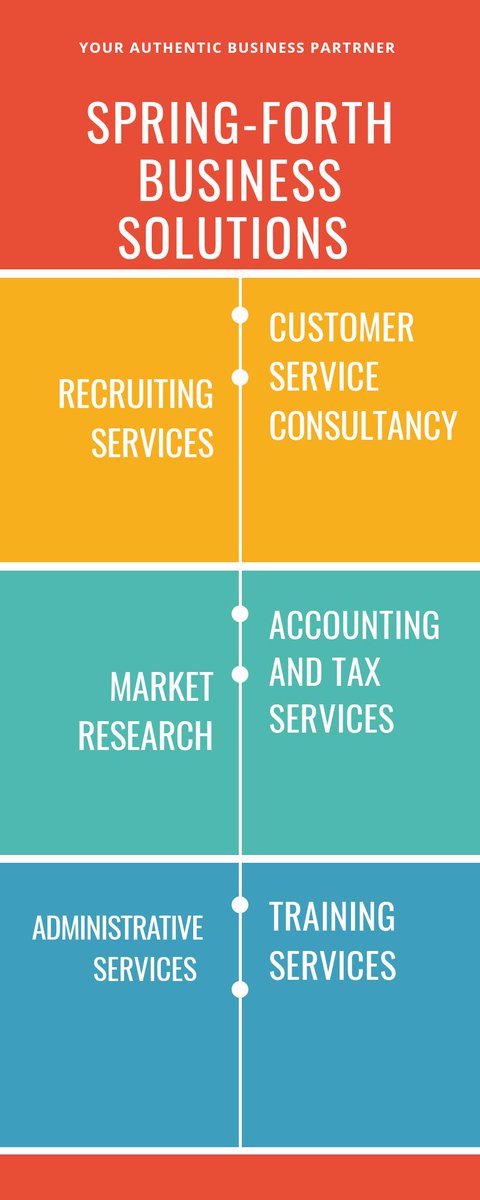 Do not feel pressure to fully abandon breast milk, formula, or purees. Not all children will be ready for baby-led weaning and finger feeding at 6 months. Focus on making sure your baby is getting enough food, rather than trying to get them to self-feed.
Do not feel pressure to fully abandon breast milk, formula, or purees. Not all children will be ready for baby-led weaning and finger feeding at 6 months. Focus on making sure your baby is getting enough food, rather than trying to get them to self-feed.
The most important thing to take away from both self-feeding and baby-led weaning is to let your baby lead the process. Let them be the one to reach for the spoon, show their curiosity, and explore their growing independence. Your baby will be most successful if you let them guide you in this process.
--------------------------------
All health-related content on this website is for informational purposes only and does not create a doctor-patient relationship. Always seek the advice of your own pediatrician in connection with any questions regarding your baby’s health.
These statements have not been evaluated by the Food and Drug Administration. Products are not intended to diagnose, treat, cure or prevent any disease.
See the FDA Peanut Allergy Qualified Health Claim at the bottom of our homepage.
How to teach a child to eat with a spoon and at what age is it better to start
Usually, parents feed their children from a spoon not out of emotion, but for practical reasons: it’s faster and cleaner. Pediatrician Olga Kulakova explains at what age a child can handle eating with a spoon and fork and whether this process can be somehow accelerated.
Question. My daughter is already 1.5 years old, and she just can't eat with a spoon on her own. By what age should a child learn to use cutlery? And are there ways to teach him?
Answer. The first acquaintance of a child with a spoon begins in the first year of life and coincides in time with the beginning of the introduction of complementary foods. At 6–7 months, the baby may begin to show interest in the spoon as an object. This is an excuse to buy another baby spoon and put it next to the plate. Let the child turn it in his hands, examine it and try to use it for its intended purpose.
Let the child turn it in his hands, examine it and try to use it for its intended purpose.
At around 9 months of age, your baby can start picking up a spoon on their own. But this does not mean that he will be able to scoop up food and bring it to his mouth. Rather, it is about the fact that the child is trying to copy the movements of adults.
A child usually masters a full-fledged spoon by about one and a half years. But here it is important to remember that everything is very individual. Someone already a year old is excellent at using a spoon, and someone is still fed by their parents even at two years old. And it’s not worth worrying that the child is over a year old, and he is still just learning and he doesn’t succeed.
Under no circumstances should children be forced to master this science. Aggressive training can cause a backlash: the child will no longer want to pick up cutlery.
How to teach a child to use a spoon:
- Have him sit at a common table, let him watch how family members eat.
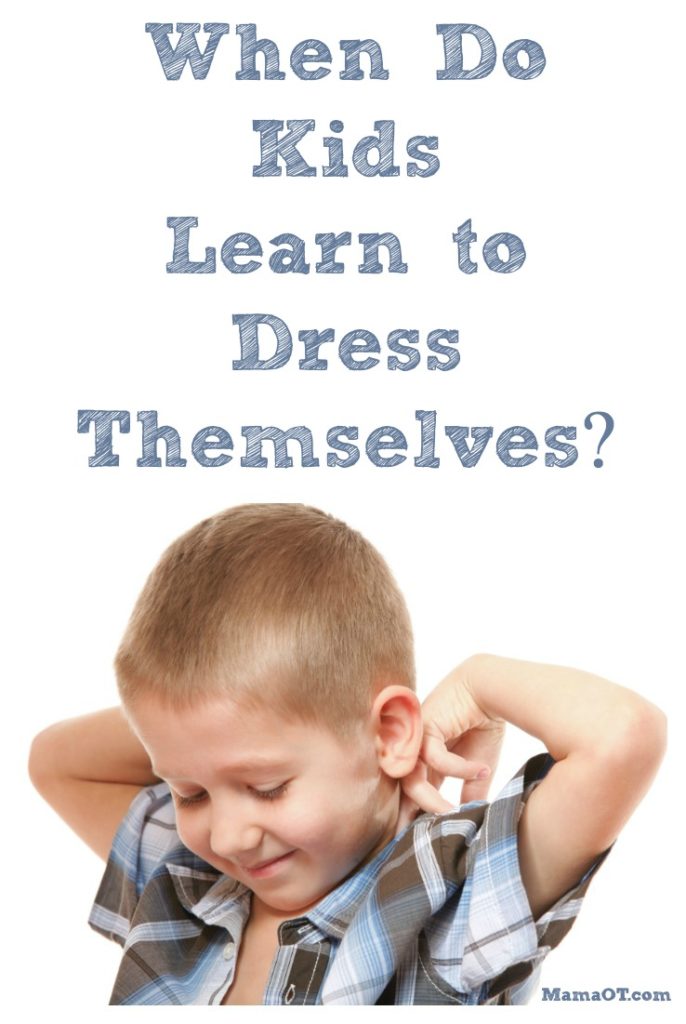
- Do not force feed your baby. Let him eat with his hands. He will not be able to eat porridge and soup like that - he will have to try to master the spoon.
- Play role-playing games with him more often, in which the child feeds his toys from a spoon.
At this age, the child actively copies the behavior of his loved ones, and it is important that he sees how the whole family eats with cutlery.
Children learn to use a fork around the age of three: at this age they already understand that a fork is a sharp object and can be hurt.
Pay attention to how the child grasps cutlery:
- At 1-2 years old, he holds a spoon in his fist in the middle of the handle.
- By two years - closer to the wide back.
- From the age of three, he can begin to hold the spoon with three fingers: thumb, index and middle.
Sooner or later the child will pick up the spoon and fork on his own as it should be
Children are given large time intervals to acquire certain developmental skills. For example, some children can learn to walk at 9 months, and others by one and a half years, and both will be the norm. The same story with cutlery: one child may become interested in them at 7–8 months, another at 9 months or after a year. All of these are variations of the norm.
For example, some children can learn to walk at 9 months, and others by one and a half years, and both will be the norm. The same story with cutlery: one child may become interested in them at 7–8 months, another at 9 months or after a year. All of these are variations of the norm.
However, by the age of two, a child should normally pick up a spoon and try to eat on his own. This does not mean that he will eat all the soup in the bowl, but at least a few spoons he should be able to bring to his mouth.
Ask your question to Mel, and the editors will find someone who can answer it. Write to our social networks - we read all messages on the pages on Facebook, VKontakte and Odnoklassniki. You can also write to us on Instagram. Answers will be published in order of priority in the "Question - Answer" section. By the way, we do not disclose names, so questions can be anything (feel free!).
Prepared by the trainee Anastasia Shirokova. Cover photo: Shutterstock / FotoDuets
What time do children start eating on their own?
Many mothers and fathers are often interested in: what time do children start eating on their own? There is no single answer to this question, everyone is individual. But it is important for parents to know: how to discern the first impulses for independence in time, at what age you can give your baby a spoon, how to teach him to eat without outside help, and what accessories will help the baby master this difficult science.
But it is important for parents to know: how to discern the first impulses for independence in time, at what age you can give your baby a spoon, how to teach him to eat without outside help, and what accessories will help the baby master this difficult science.
What time do children start eating by themselves with a spoon?
It depends on the character and development of the child, as well as on his parents. Some children already in the year flatly refuse to be fed with a spoon. But there are those who start eating on their own only at the age of 3, when they come to kindergarten (in a team, children involuntarily imitate others and the learning process goes faster). In large families, children learn self-service skills at an earlier age.
But overprotection hinders the development of the baby. If an overly caring mother tries to do everything for the child, then he will not strive to eat himself, even if he can do it. If parents are too much in favor of accuracy, and porridge smeared on the table causes them stress, then the learning process can slow down. After all, the baby feels the mood of adults, and prefers not to experiment at the table. The lack of independence can also be associated with an unwillingness to grow up. For example, another baby has appeared in the family, and the child, feeling that they are paying less attention to him, tries to “stay small”, wants his mother to take him in her arms more often, feed him from a spoon, etc.
After all, the baby feels the mood of adults, and prefers not to experiment at the table. The lack of independence can also be associated with an unwillingness to grow up. For example, another baby has appeared in the family, and the child, feeling that they are paying less attention to him, tries to “stay small”, wants his mother to take him in her arms more often, feed him from a spoon, etc.
From the age of 7 months a child usually learns to grasp and hold objects between thumb and forefinger, such as a dryer or a piece of bread. The child can be offered a spoon when he is already receiving complementary foods and sits well in the highchair. At first, the baby will only try to take the spoon in his hands and play with it, but later he will try to use it for its intended purpose. For drinking to a baby up to a year, a drinking mug is convenient.
At 12 months the child still does not hold the spoon correctly, but he knows how to bring it to his mouth, and some of the contents can reach the goal. Closer to two years, coordination improves significantly, the baby is capable of more precise movements and misses less and less. The kid can already hold a regular mug, but only with two hands.
Closer to two years, coordination improves significantly, the baby is capable of more precise movements and misses less and less. The kid can already hold a regular mug, but only with two hands.
From the age of 2 years a child can eat by himself with a spoon, although he does not always do it sloppy. He already holds a mug with one hand and knows how to use a fork.
From the age of 3 the baby becomes more dexterous and accurate, his fingers are getting stronger, and his movements are more and more confident. It is quite possible to give him a non-sharp children's knife, having previously shown how to use it.
Accessories to help children learn to eat on their own
Buy a baby plate with a suction cup so that the dishes do not run away from the child. It’s good if the child’s favorite character is drawn at the bottom of the plate. To see the picture, the baby will try quickly and eat all the food to the end.
The non-spill cup is the best option when switching to adult dishes. Choose a model with two handles, it is more convenient for your baby to hold. An additional advantage is the presence of a rubber stand, which gives the cup stability.
Choose a model with two handles, it is more convenient for your baby to hold. An additional advantage is the presence of a rubber stand, which gives the cup stability.
A special anatomically shaped spoon with a rounded non-slip handle and a curved fork with rounded teeth are best suited for babies up to a year old.
Paper napkins or towels should always be at hand. This teaches you to be careful, helps to avoid the temptation to wipe your hands on clothes.
It is good if a grown child eats at a common table. He will be able to watch adults, copy their actions. To do this, the baby will need a special chair that can be attached to a large table (for example, high chairs from IKEA, “growing” Stokke Tripp Trapp, Kotokota, KidFix, etc.)
Buy your baby a soft silicone bib, oilcloth or apron. This will help parents save their nerves and spend less time on laundry and cleaning.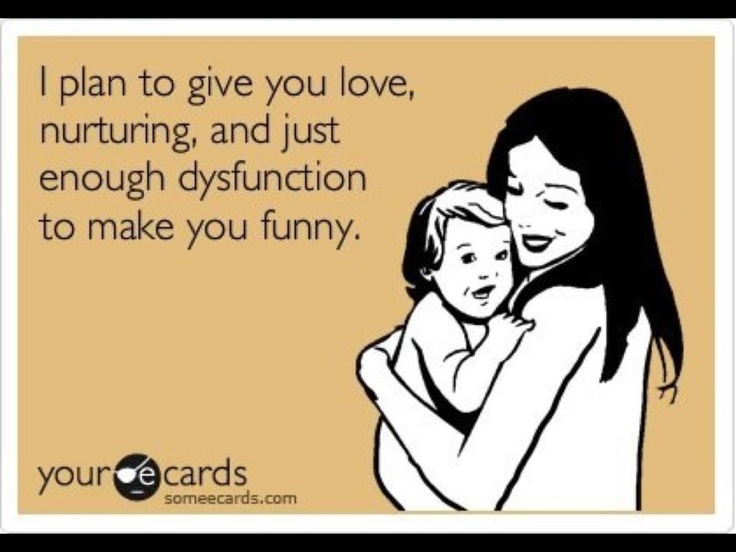
How to teach a baby to eat without the help of adults?
If, during feeding, the baby seeks to take away the mother's spoon and tries to eat by himself, then “the time has come”. Use this moment!
At first, it is difficult for the baby to eat liquid food on his own, such as soup. And he probably wants to take pieces of fruit or pasta with his hands. Therefore, the ideal food for the first workouts is porridge or vegetables, which must first be kneaded with a fork.
The game will be a good help in learning. You can train the skill in the sandbox. Help the baby to scoop up the sand with a spatula, carefully pour it into the mold, make a cake. Buy a set of toy dishes, let the child feed dolls and teddy bears with a small spoon. This improves coordination, develops fine motor skills and will help him handle real cutlery.
At the beginning of training, one spoon should be in the hands of the mother, and the second - in the child.

